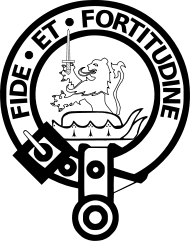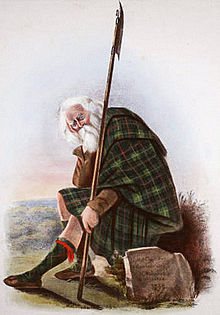- Clan Farquharson
-
Clan Farquharson Crest badge 
Crest: On a chapeau Gules furred Ermine, a demi-lion Gules holding in his dexter paw a sword Proper Motto: Fide et Fortitudine ("By Faith and Fortitude") Profile Plant badge Scots fir, red whortleberry, or foxglove Chief

Alwyne Farquharson of Invercauld Chief of the Name and Arms of Farquharson Seat The Valley Farm, Norfolk.[1] Septs of Clan Farquharson Barrie, Bowman, Brebner, Bremner, Bryant, Carracher, Clan Christie, Christison, Christy, Coates, Coats, Coutts, Cromar, Farquhar, Ferries, Findlay, Findlayson, Findlaison, Findley, Finlay, Finlayson, Finley, Gracie, Grassick, Greusach, Hardie, Hardy, Herald, Higgins, Higginson, Kellas, Kerracher, Leys, Lion(s), Lyon(s), MacArtney, MacGaig, MacCartney, MacCraig, MacCuaig, MacEaracher, MacErcher, MacErracher, MacFarquhar, MacFerchar, MacHardie, MacHardy, MacKerchar, MacKerracher, MacKindlay, MacKinlay, MacKinley, MacWade, McKinley, Paterson, Patterson, Pattison, Reaich, Reoch, Riach, Souders, Soutter, Tawse, Tay, Wade, Wood[2]  A romantic depiction of a clansman illustrated by R. R. McIan, from James Logan's The Clans of the Scottish Highlands, 1845.
A romantic depiction of a clansman illustrated by R. R. McIan, from James Logan's The Clans of the Scottish Highlands, 1845.
 Carn na Cuimbne or the Cairn of Memory is among the trees on the north bank of the river. It was here that the Clan Farquharson mustered their men and prepared for whatever battle they had been summoned to fight. Each man left a stone on the cairn and removed it when he returned. The stones which remained marked the number of those who had died.
Carn na Cuimbne or the Cairn of Memory is among the trees on the north bank of the river. It was here that the Clan Farquharson mustered their men and prepared for whatever battle they had been summoned to fight. Each man left a stone on the cairn and removed it when he returned. The stones which remained marked the number of those who had died.
 Farquharson Modern
Farquharson Modern
Clan Farquharson of Invercauld is a Highland Scottish clan. The clan hails from Aberdeenshire and is a member of the Chattan Confederation.[3]
Contents
History
Origins
Farquhar - from the Gaelic 'fear' and 'char' meaning 'dear one'. In modern Scottish Gaelic, the surname is written "MacFhearchair".
The clan derives its name from Farquhar Shaw, 4th son of Alexander "Ciar" Mackintosh of Rothiemurchus, 5th Chief of the Clan Shaw, who settled in the Braes of Mar, the source of the River Dee. His descendants took the name Farquharson.[3]
16th century and Anglo-Scottish Wars
Farquhar Shaw's son married Isobel Stewart, heiress of Invercauld, however, it was their son, Finlay Mor who has become known as the first real Farquharson. He was killed during the Battle of Pinkie in 1547, aged 60, while performing the duty of the King's Standard Bearer. This was part of the Anglo-Scottish Wars.[3]
His nine sons ensured that the clan became numerous and influential. In 1595 the clan entered a bond of manrent with the Clan MacKintosh, so also associating themselves with the Chattan Confederation.
At the end of the sixteenth century the Erskines attempted to reclaim the Earldom of Mar. Jon Erskine, who styled himself Earl of Mar, built Braemar Castle in 1628 to defend himself against the claims of the Farquharsons. The castle passed into the hands of the Farquharsons and remains the clan seat to this day.
17th century, clan conflicts and Civil War
In 1673 a skirmish took place between the Clan Farquharson and the Clan MacThomas. Of the six sons born from the clan MacThomas chief John and Robert, the eldest and fourth eldest respectively were killed in a skirmish at Drumgley on 28 January 1673. The feud was as a result of the MacThomases allowing their cattle to pasture on the Farquharson's land. After the skirmish the MacThomases were fined, there was a crippling lawsuit made against them. After the chiefs death which followed the remaining sons were forced to sell their lands.
The Farquharsons were staunch supporters of the House of Stuart and in 1689, John Farquharson of Inverey declared for John Graham of Claverhouse, Bonnie Dundee. He burned Braemar Castle and was a source of irritation to the government until his death in 1698.
18th century and Jacobite uprisings
During the 1715 Rebellion, John Farquharson of Invercauld supported the Chattan Confederation and was a colonel of the regiment in support of James Francis Edward Stuart.
In 1745 the strength of the Clan Farquharson was estimated as 500 by Forbes of Culloden.[3] In 1745 the Clan Farquharson are believed to have supported Lord Lewis Gordon during his victory at the Battle of Inverurie (1745). Also during the 1745 Jacobite Rising, Angus, the chief of Clan MacKintosh, was a serving member of the British Black Watch. While he was away on duty his wife, Lady Anne Mackintosh, daughter of Invercauld was a supporter of Charles Edward Stuart and ensured that 350 members of the Clan Chattan Regiment fought at the Battle of Culloden on the side of the Jacobites. During her husband's absence, she successfully rallied the Clan Mackintosh to their Chattan allies including Clan Farquharson. Angus was captured at the Battle of Prestonpans and was paroled to his wife. She famously greeted him with the words, "Your servant, captain" to which he replied, "your servant, colonel" thereby giving her the nickname Colonel Anne.
Modern clan
The Chief of Clan Farquharson is Alwyne Arthur Compton Farquharson of Invercauld, Chief of the Name and Arms of Farquharson, 16th Baron of Invercauld and Omnalprie, MC, JP; as recognised by Lord Lyon King of Arms.[4] Captain Alwyne Arthur Compton Farquharson of Invercauld was by Lyon Court in 1949 confirmed MacFionnlaidh. He served with distinction as a Captain in the Royal Scots Greys during World War Two. He resides at Invercauld Castle in Braemar on Royal Deeside. [5]
Castles
- Inverey Castle was the seat of the chief of Clan Farquharson.
- Braemar Castle was attacked and burned by John Farquharson, the Black Colonel of Inverey in 1689, killing John Erskine. The castle was left in ruins until 1748 when it was leased to the government by the Clan Farquharson.
- Invercauld House is the seat of the current chief of Clan Farquharson, Captain Alwyn Compton Farquharson.
Clan Profile
- Crest: On a chapeau Gules furred Ermine, a demi-lion Gules holding in his dexter paw a sword Proper.
- Motto: Fide et Fortitudine ("Fidelity and Fortitude") and (On compartment) I force nae freen, I fear nae foe.
There are several tartans attributed to the name Farquharson.
See also
References
- ^ clanchiefs.org
- ^ James Logan's The Clans of the Scottish Highlands, 1845
- ^ a b c d "The Scottish Clans and Their Tartans”. W. & A. K. Johnston Limited. Edinburgh and London. 1886. Page 20.
- ^ "FARQUHARSON OF INVERCAULD, CHIEF OF FARQUHARSON". http://www.burkes-peerage.net/familyhomepage.aspx?FID=0&FN=FARQUHARSONOFINVERCAULD.
- ^ "Faquharson Clan UK". http://www.farquharson-clan.co.uk/content/history.htm.
External links
Scottish clans Clans with chiefs Agnew · Anstruther · Arbuthnott · Arthur · Bannerman · Barclay · Borthwick · Boyd · Boyle · Brodie · Broun · Bruce · Buchan · Burnett · Cameron · Campbell · Carmichael · Carnegie · Cathcart · Charteris · Chattan · Chisholm · Cochrane · Colquhoun · Colville · Cranstoun · Crichton · Cumming · Darroch · Davidson · Dewar · Drummond · Dunbar · Dundas · Durie · Elliot · Elphinstone · Erskine · Farquharson · Fergusson · Forbes · Forsyth · Fraser · Fraser of Lovat · Gayre · Gordon · Graham · Grant · Gregor · Grierson · Guthrie · Haig · Haldane · Hamilton · Hannay · Hay · Henderson · Home · Hope · Hunter · Irvine · Jardine · Johnstone · Keith · Kennedy · Kerr · Kincaid · Lamont · Leask · Lennox · Leslie · Lindsay · Lockhart · Lumsden · Lyon · MacAlister · MacBain · MacDonald · Macdonald of Clanranald · MacDonald of Keppoch · Macdonald of Sleat · MacDonell of Glengarry · MacDougall · Macdowall · MacIntyre · Mackay · Mackenzie · Mackinnon · Mackintosh · Maclachlan · Maclaine of Lochbuie · MacLaren · MacLea (Livingstone) · Maclean · MacLennan · MacLeod · MacLeod of Lewis · MacMillan · Macnab · Macnaghten · MacNeacail · MacNeil · Macpherson · MacTavish · MacThomas · Maitland · Makgill · Malcolm (MacCallum) · Mar · Marjoribanks · Matheson · Menzies · Moffat · Moncreiffe · Montgomery · Morrison · Munro · Murray · Napier · Nesbitt · Nicolson · Ogilvy · Oliphant · Primrose · Ramsay · Rattray · Riddell · Robertson · Rollo · Rose · Ross · Ruthven · Sandilands · Scott · Scrymgeour · Sempill · Shaw · Sinclair · Skene · Spens · Stirling · Strange · Stuart of Bute · Sutherland · Swinton · Trotter · Urquhart · Wallace · Wedderburn · Wemyss · Wood ·
Armigerous clans Abercromby · Abernethy · Adair · Adam · Aikenhead · Ainslie · Aiton · Allardice · Anderson · Armstrong · Arnott · Auchinleck · Baillie · Baird · Balfour · Bannatyne · Baxter · Bell · Belshes · Bethune · Beveridge · Binning · Bissett · Blackadder · Blackstock · Blair · Blane · Blyth · Boswell · Brisbane · Buchanan · Butter · Byres · Cairns · Calder · Caldwell · Callender · Campbell of Breadalbane · Campbell of Cawdor · Carruthers · Cheyne · Chalmers · Clelland · Clephane · Cockburn · Congilton · Craig · Crawford · Crosbie · Cunningham · Dalmahoy · Dalrymple · Dalzell · Dennistoun · Don · Douglas · Duncan · Dunlop · Edmonstone · Fairlie · Falconer · Fenton · Fleming · Fletcher · Forrester · Fotheringham · Fullarton · Galbraith · Galloway · Gardyne · Gartshore · Ged · Gibsone · Gladstains · Glas · Glen · Glendinning · Gray · Gunn · Haliburton · Halkerston · Halket · Hepburn · Heron · Herries · Hogg · Hopkirk · Horsburgh · Houston · Hutton · Inglis · Innes · Kelly · Kinloch · Kinnaird · Kinnear · Kinninmont · Kirkcaldy · Kirkpatrick · Laing · Lammie · Langlands · Learmonth · Little · Logan · Logie · Lundin · Lyle · MacAulay · Macbrayne · MacDuff · MacEwen · MacFarlane · Macfie · Macgillivray · MacInnes · MacIver · Mackie · MacLellan · Macquarrie · Macqueen · Macrae · Masterton · Maule · Maxton · Maxwell · McCorquodale · McCulloch · McKerrell · Meldrum · Melville · Mercer · Middleton · Moncur · Monteith · Monypenny · Mouat · Moubray · Mow · Muir · Murray of Atholl · Nairn · Nevoy · Newlands · Newton · Norvel · Ochterlony · Orrock · Paisley · Paterson · Pennycook · Pentland · Peter · Pitblado · Pitcairn · Pollock · Polwarth · Porterfield · Preston · Pringle · Purves · Rait · Ralston · Renton · Roberton · Rossie · Russell · Rutherford · Schaw · Seton · Skirving · Somerville · Spalding · Spottiswood · Stewart · Stewart of Appin · Strachan · Straiton · Strange · Sydserf · Symmers · Tailyour · Tait · Tennant · Troup · Turnbull · Tweedie · Udny · Vans · Walkinshaw · Wardlaw · Watson · Wauchope · Weir · Whitefoord · Whitelaw · Wishart · Young
Culture and society Scotland · Clan chief · Septs · Clan badge · Clan crest · Clan battles · Tartan · Bagpipes · Clearances · Kilt · Manrent · The Highlands · Battle of Culloden · Highland games · Border Reivers · Scottish heraldry · Scottish surnames
Categories:- Scottish clans
Wikimedia Foundation. 2010.


